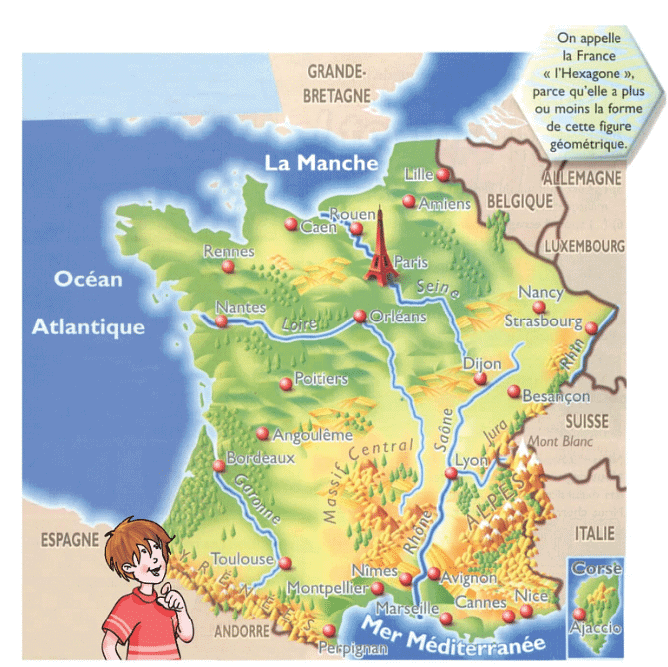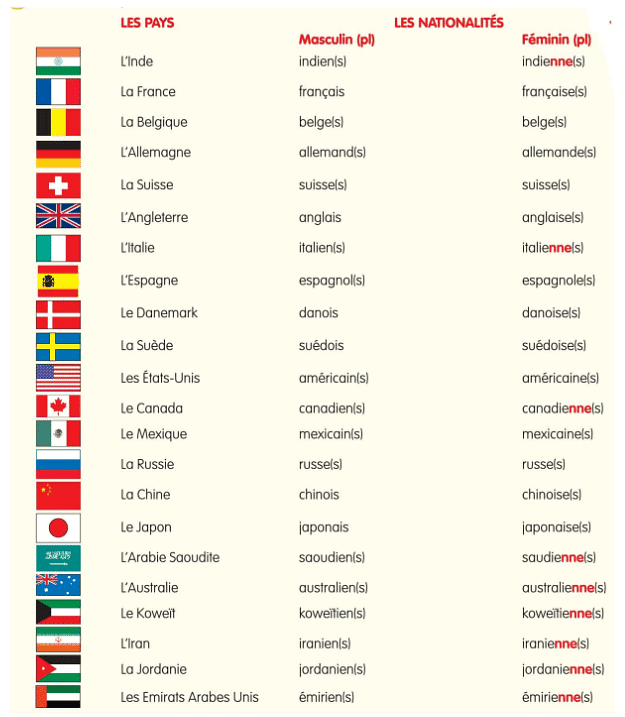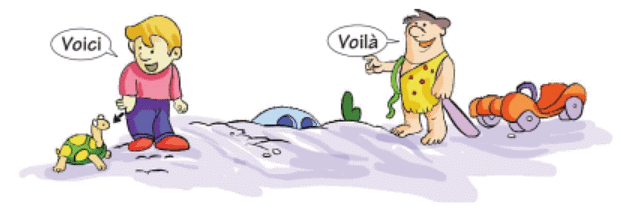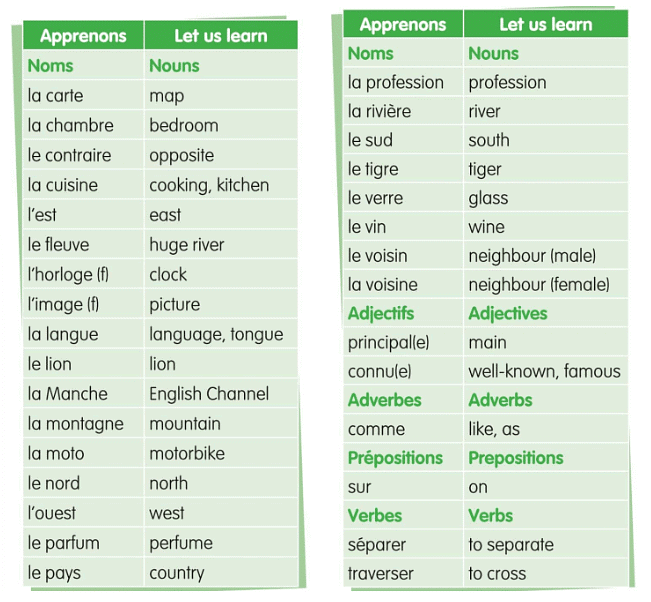Mon Pays : la France Chapter Notes | French for Class 6 PDF Download
| Table of contents |

|
| Écoutez, puis lisez |

|
| Accord des adjectifs (Agreement of adjectives) |

|
| Making an adjective plural |

|
| Il y a, Voici, Voilà |

|

Mon pays: la France
(mohn pay-ee: la frahns)
My country: FranceVoici la carte de mon pays : la France.
(vwah-see la kart duh mohn pay-ee: la frahns)
Here is the map of my country: France.Paris est la capitale de la France.
(pah-ree ay la ka-pee-tal duh la frahns)
Paris is the capital of France.Il y a cinq fleuves importants en France : la Seine, la Loire, la Garonne, le Rhône et le Rhin.
(eel ee ah sank fluhv ahm-por-tahn ahn frahns: la sen, la lwahr, la ga-ron, luh ron ay luh ran)
There are five important rivers in France: the Seine, the Loire, the Garonne, the Rhône, and the Rhine.La Seine traverse la ville de Paris.
(la sen trah-vehrs la veel duh pah-ree)
The Seine runs through the city of Paris.Les montagnes principales de la France sont : les Pyrénées dans le sud-ouest, les Alpes dans le sud-est.
(ley mon-tahn prahn-see-pal duh la frahns sohn: ley pee-ray-nay dah luh sood-oo-est, ley alp dah luh sood-est)
The main mountains of France are: the Pyrenees in the southwest, and the Alps in the southeast.Les pays voisins de la France sont : l'Espagne au sud, l'Italie et la Suisse à l'est, l'Allemagne et la Belgique au nord-est, et la Grande-Bretagne au nord-ouest, séparés par La Manche.
(ley pay vwah-zahn duh la frahns sohn: les-pan-yuh oh sood, lee-tah-lee ay la sweess ah lest, lah-le-man-yuh ay la bel-zheek oh nord-est, ay la grahnd-bre-tahn oh nord-oo-est, say-pah-ray par la manch)
The neighboring countries of France are: Spain to the south, Italy and Switzerland to the east, Germany and Belgium to the northeast, and Great Britain to the northwest, separated by the English Channel.Les pays voisins de la France sont: au nord - la Belgique et l’Angleterre; à l’est - l’Allemagne, la Suisse et l’Italie; au sud – l’Espagne. À l’ouest, il y a l’océan Atlantique. La Manche sépare la France de l’Angleterre.
(ley pay vwah-zahn duh la frahns sohn: oh nohr - la bel-zheek ay lan-gle-tehr; ah lest - la-le-man-yuh, la sweess ay lee-tah-lee; oh sood – les-pan-yuh. ah loo-est, eel ee ah loh-se-an at-lahn-teek. La manch say-par la frahns duh lan-gle-tehr.)
The neighboring countries of France are: to the north - Belgium and England; to the east - Germany, Switzerland, and Italy; to the south - Spain. To the west, there is the Atlantic Ocean. The English Channel separates France from England.La France est connue pour ses fromages (le camembert, le brie, le roquefort), sa cuisine et ses parfums (Chanel, Christian Dior, Pacco Rabane etc.)
(la frahns ay kon-new poor say froh-mahzh (luh ka-man-bear, luh bree, luh rok-for), sa kwee-zeen ay say par-fum (shah-nel, krees-tyan dee-or, pah-ko ra-ban et-set-er-ah))
France is known for its cheeses (Camembert, Brie, Roquefort), its cuisine, and its perfumes (Chanel, Christian Dior, Paco Rabanne, etc.).
Écoutez, puis lisez

Accord des adjectifs (Agreement of adjectives)
Generally, an "e" is added to the masculine form in order to make an adjective feminine.
grand + e → grande
(grahn + uh → grahnd)
tall (masc.) + e → tall (fem.)haut + e → haute
(oh + uh → oht)
high (masc.) + e → high (fem.)court + e → courte
(koor + uh → koort)
short (masc.) + e → short (fem.)
If the masculine form of the adjective ends with an "e", it remains the same in the feminine form.
jeune → jeune
(zheuhn → zheuhn)
young (masc.) → young (fem.)rouge → rouge
(roozh → roozh)
red (masc.) → red (fem.)
The feminine of certain adjectives is formed by doubling the final consonant of the masculine form and then adding "e".
gros + se → grosse
(gro + suh → gros)
fat (masc.) + e → fat (fem.)bon + ne → bonne
(bon + nuh → bon)
good (masc.) + e → good (fem.)
Adjectives ending with "eau" in the masculine form change to "elle" to get their feminine form.
- beau → belle
(bo → bell)
handsome (masc.) → beautiful (fem.)
- beau → belle
Making an adjective plural
In most cases, an adjective is made plural by adding 's' to its singular form.
- grand (grahn) - large → grands (grahn)
- large (larzh) - wide → larges (larzh)
- haut (oh) - high → hauts (oh)
- joli (zho-lee) - pretty → jolis (zho-lee)
- noir (nwar) - black → noirs (nwar)
If an adjective already ends with 's' in its masculine singular form, there is no change in the plural form.
- gros (groh) - fat → gros (groh)
- épais (ay-pay) - thick → épais (ay-pay)
- gris (gree) - grey → gris (gree)
An adjective ending in 'eau' in the singular form is made plural by adding an 'x'.
- beau (boh) - beautiful → beaux (boh)
- nouveau (noo-vo) - new → nouveaux (noo-vo)
The feminine plural of adjectives is formed by adding 's' to the feminine singular form.
- grande (grahnd) - tall → grandes (grahnd)
- belle (bell) - beautiful → belles (bell)
- grise (greez) - grey → grises (greez)

Il y a, Voici, Voilà

Il y a (eel ee ah) - there is, there are
This phrase is used to indicate the existence or presence of something.Voici (vwah-see) - here is, here are
This phrase is typically used to present something or someone.Voilà (vwah-lah) - there is, there are
Similar to 'voici', it is used to present something or someone but can also indicate that something is a bit further away or has been found.
|
17 videos|44 docs
|















